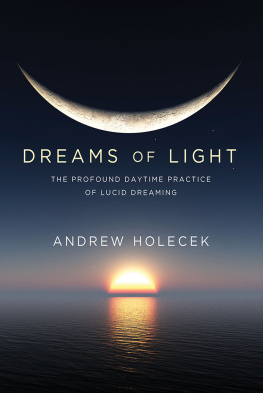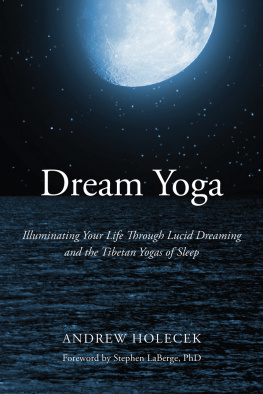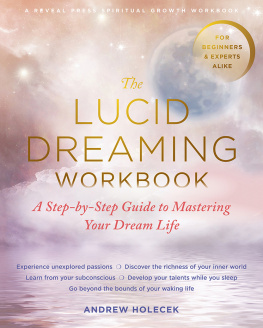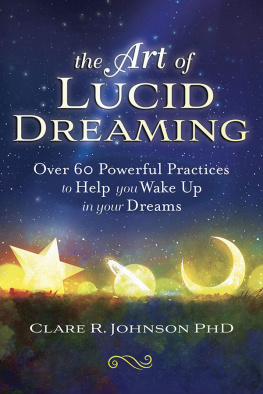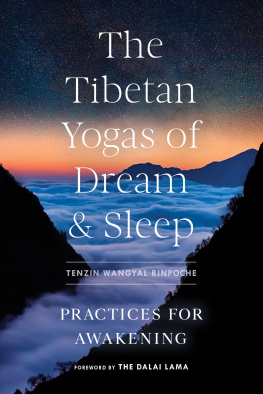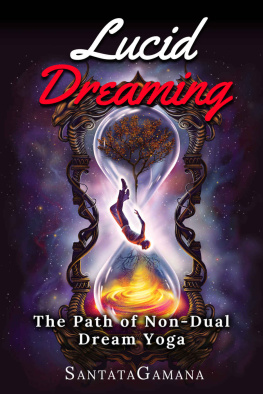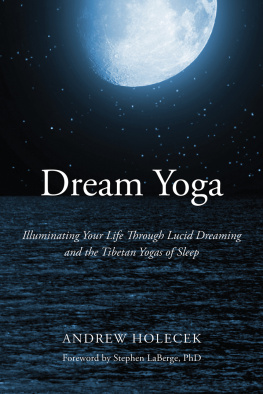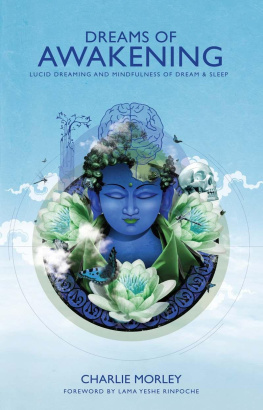For my brother Frank,
the embodiment of integrity and goodness
CONTENTS
INTRODUCTION
In our ordinary life, were like dreamers believing that the dream were having is real. We think were awake, but were not. We think that this busy mind of thoughts and emotions is who we truly are. But when we actually wake up, our misunderstanding about who we areand the suffering that confusion bringsis gone.
DZOGCHEN PONLOP
Lucid dreaming and dream yoga are marvelous practices for psychological and spiritual growth. When fully developed, they represent a revolution in higher education, a unique night school. Instead of wasting a third of your life lost in the darkness of non-lucid sleep, you can turn on the internal night light, stay up for more of the night, and discover an entire world inside. The possibilities for rapid transformation and boundless learning are breathtaking.
Lucid dreaming is a radical, transformative medium, but like any advanced education its not always easy. Ive traveled the world teaching these nocturnal practices for many years, and people get enthusiastic about the opportunities that await them every night. But without proper preparation, excitement is replaced with discouragement. So much is promised, so little delivered. Some individuals wrestle with attaining lucidity and then sustaining it. Others might have unreasonable expectations or struggle with impatience. Still others grapple with fear or anxiety about what they might find lurking in the dark. Youre dealing with subtle states of consciousness in the dark, and the power of habit is never more forcefully unleashed than during sleep and dream. In order to enter this internal institute of higher learning and not drop out, some encouragement and remedial work is needed. This book is here to provide you with that necessary ground.
Mixing metaphors: to deliver the nighttime goods, you need a sturdy daytime vehicle. You need an all-terrain vehicle or, in our context, an all-states of consciousness practice. Something that can transport you lucidly from waking consciousness deep into the dark, then deliver you back into the waking state loaded with the insights youve gathered from your trip. This is the role of the daytime practice of illusory form. Its the ideal ATV, a practice applicable to all these states of consciousness.
The relationship of illusory form practice to dream yoga (which includes lucid dreaming) is distinctive. On the one hand, illusory form is the best preparation for dream yoga, as well as the principal remedy for many of the hurdles that accompany that practice. On the other hand, seeing everything as illusory is the fruition of dream yoga. So, illusory form practice frames dream yoga. Its simultaneously the ideal preparatory practice for dream yoga (which is when its called impure illusory form) and also its final performance (referred to as perfectly pure illusory form). Its the perfect fake it till you make it practice.
My previous book, Dream Yoga: Illuminating Your Life Through Lucid Dreaming and the Tibetan Yogas of Sleep, introduced a progression of nocturnal meditations: lucid dreaming, dream yoga, sleep yoga, and bardo yoga. Dreams of Light takes a deeper look at the essence of these practices, now held within the larger context of the daytime practices of illusory form. Because illusory form is both the beginning and the end of our path, the preliminary practice for the nocturnal yogas of sleep and also their fruition, it transforms a linear journey into a circle.
Illusory form practices help you discover that the heaven you seek is right here on Earth. The world of form, what many spiritual seekers long to escape, is not the problem. The material world that youre living in right now is not the issue. Indeed, at the end of the path, the material is discovered to be spiritual. The practice of illusory form deposits you squarely back into the material world, but now with a liberating perspective. Its the same old place that you left behind when you began the spiritual path, but now its seen in a lucid and illuminating light. Turning on that light is our journey in this book.
Since illusory form practice sandwiches dream yoga as both the alpha and the omega, the rehearsal and final performance, its the irreducible practice. This conclusion is supported by classical texts that categorize dream yoga as a subset of illusory form. Illusory form is the main practice, with dream yoga designed to support it.
Anybody can practice illusory form. Its easy. This is great news for those who labor with the subtleties of dream yoga. When you engage in this daytime practice, you will come to the same conclusions delivered by its nighttime correlates. And by gaining proficiency in the practice of illusory form, you may well find yourself having more lucid dreams. You can therefore accomplish the essence of dream yoga through the practice of illusory form. So if youre fascinated by lucid dreaming and dream yoga but struggle with it, the practice of illusory form is for you.
Discovering the illusory and dreamlike nature of reality is the ultimate point, and that summit can be reached by either the daytime or nighttime paths.
A TWO-WAY STREET
Each one of the nocturnal meditations has diurnal correlates, daily practices designed to match the subtlety of the mind as its revealed in the dark, and which will come to light in the meditations on the eight consciousnesses described in part 2 of this book. They dilate our meditative eyes during the day. Without the daily meditations, its difficult to recognize dreaming and sleeping consciousness. Its hard to identify something in the dark that you havent met in the light of the day. Youll walk right past these states. But if you spend time getting familiar with these subtle states now (the very definition of meditation in Tibetan is gomto become familiar with), you will start to recognize them in the dark. What the poet Kabir said of death also applies to sleep and dream: What is found now is found then. Conversely, for the untrained mind, what is not found now is not found then.
Illusory form and dream yoga, the diurnal and nocturnal, support each other, so working with both practices creates a kind of staircase between two states of consciousness that eventually lifts you into their fundamental unity. Imagine a staircase in the shape of triangle, wide at the bottom and converging at the top. Waking and dreaming are as far apart as black and white, night and day when you start to climb this staircase, but the higher you climb, the closer they get. So this staircase is also a bridge. At the summit, illusory form and dream yoga allow you to experience the equality of awareness that Buddhism refers to as one taste. In Christian terms, everything tastes like God.
It may seem like a lofty state, but uniting waking and dreaming consciousness is one definition of both lucid dreaming and illusory form. In other words, bringing waking consciousness into the dream state defines a lucid dream; bringing lucid dream consciousness into the waking state (and therefore seeing daily appearances as dreamlike) defines the practice of illusory form. The fruition of both practices is to wake up to the nonsolidity or empty nature of both states.
Illusory form practice and dream yoga open a bustling two-way street with insights flowing in both directions. They are reciprocating practices. What you practice with illusory form meditation will enhance what you practice if you are working with dream yoga; conversely, what you practice with dream yoga will enhance your practice of illusory form.

